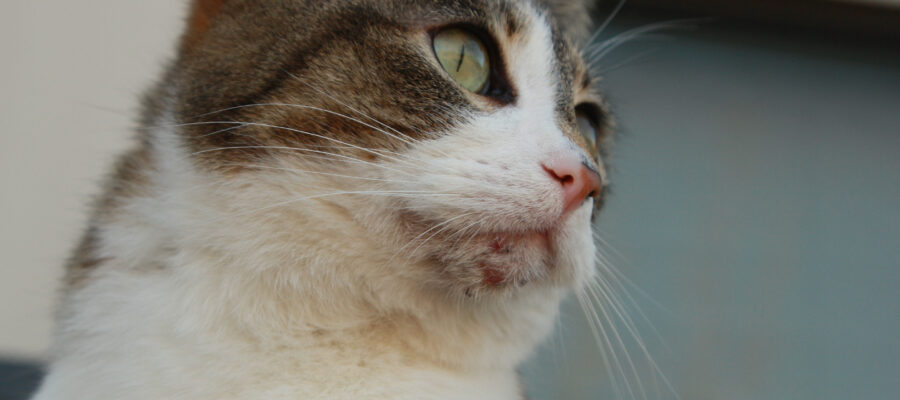Feline Acne – How You Can Help Your Cat

By Patricia Thomblison, DVM, MS
Did you think acne was just for teenagers? Wrong. Cats can be plagued with acne as well. While cat acne is usually not a serious condition, it can cause discomfort and irritation for the cat.
WHAT DOES IT LOOK LIKE?
It often is on the chin or near the lips. It may look like brown or black specks of dirt cover the chin, or there may be red bumps and pimple like lesions. Hair follicles produce too much keratin and become plugged. It may be a one-time occurrence, or it may become a chronic condition.
CAUSE
The exact cause is not known. It occurs in in males and females, and in all ages of cats. Although cause is poorly understood it appears to be related to the overproduction of keratin which becomes blocked causing blackheads to form. If these blackheads become infected, they look like pustules or pimples. Feline acne may also be associated with poor grooming, food allergies, contact allergies, stress, and poor immune systems. Other skin diseases such as parasites (fleas and mange), ringworm, and eosinophilic granuloma disease complex may increase the likelihood of developing feline acne.
FIRST STEPS
One of the first recommendations is to change food and water bowls from plastic to metal, glass or ceramic. It is possible the plastic dishes may cause contact sensitivity, or the rougher surface of plastic dishes may harbor bacteria. Metal, glass, and ceramic dishes should be washed regularly to avoid contamination.
CLEANING THE AREA
The area around the chin should be gently cleansed. Shampoos and wipes can be used, but avoid products with alcohol or peroxide as these ingredients can irritate the skin and exasperate the condition. Use products specifically made for cats. Use of a product like ZYMOX® Shampoo is an effective way to cleanse and protect the natural barrier of the skin. A skin topical, such as ZYMOX Topical Cream for Cats and Kittens can be beneficial as well. This cream has a catheter tip for direct application to the face and features a proprietary formulation of enzymes that are effective against fungus and bacteria. These products have been helping cats for over two decades and they are also endorsed by The International Cat Association (TICA).
ONGOING CARE
Some cats will have one case of feline acne and never have another one. Others will have recurrence and need continuous care to prevent and manage. If you notice a recurrence after introducing a new food or toy, remove the newly introduced item for at least 30 days. Getting into a routine of cleaning your cat’s chin after feeding has been found to be very helpful and a potential way to minimize flares. Trimming the hair around the chin may also decrease the chance of recurrence.
IF THINGS GO WRONG
While most cases of feline acne are mild and respond to home therapy, occasionally cases will get worse and will need to be seen by a veterinarian. The signs to be watchful include crusty lesions, acne spreading, signs of pain or discomfort, hair loss, and new or exaggerated itching.
CHIN UP
Although feline acne is unsightly it usually isn’t painful and can be managed at home. Monitoring your cat for any signs of irritation on the chin can keep you ahead of problems. Simple solutions such as changing feeding/watering dishes and a simple cleaning routine will help your cat keep ahead of the problem.


